Git
What is Git
Git is a distributed version-control system for tracking changes in source code during software development. It is designed for coordinating work among programmers, but it can be used to track changes in any set of files.
Git lets us keep track of versions of our code, just like saving a Word document
Git lets us easily see differences between versions of code
Git does this in a distributed manner
Git is the defacto standard for VCS
It is a must for working with code in this day and age
Exercise
Create an empty directory we can work with
$ mkdir git_demo && cd git_demo
Check that it is empty
$ ls -a
. ..
Initialize a new repo
To have git track our code, we must tell git that it should create a new repository
Git Init
$ git init
Initialized empty Git repository in /home/anders/projects/git_demo/.git/
Now there should be something in your directory
$ ls -a
. .. .git
Open up the magic directory
Let’s have a quick peek under the covers
Look, don’t touch - You will (almost) never need to do anything in here
$ tree -a .git
.git
├── branches # Any branches are stored here
├── config # Any local configuration is here
├── description # used by gitweb
├── HEAD # points at the HEAD commit
├── hooks # Any scripts you want to run during the git lifecycle
├── info # Contains a local exclude
├── objects # The key-value database
└── refs # Stores the names of references
Let’s actually do some work and come back to this
Committing files
The git workflow
- git status
- git add
- git commit
Git status
git status gives us information about the current state of git
$ git status
On branch master
No commits yet
nothing to commit (create/copy files and use "git add" to track)
Notice it gives us an indication of what our next step might be
Exercise
Create a new file named example.txt and write some text
Git add
Now we have some text - run git status again
$ git status
On branch master
No commits yet
Untracked files:
(use "git add <file>..." to include in what will be committed)
example.txt
nothing added to commit but untracked files present (use "git add" to track)
We have a new untracked file - untracked means git has not added it to it’s database yet
Let’s track the file
$ git add example.txt
$ git status
On branch master
No commits yet
Changes to be committed:
(use "git rm --cached <file>..." to unstage)
new file: example.txt
We are now ready to commit our file - aka “Press Save”.
We need to provide a commit message
A good commit message is a helper for yourself if you ever need to go back in time!
$ git commit
Aside - Commit messages
A good commit message should have a title - use verbs to describe what this commit will do!
Update/Add/Fix/Createetc
It should also have a descriptive body - a more detailed outline of what is happening
Don’t be this guy:
Where did our file go?

Update the file
Now that we have a file under version control, let’s change it
Exercise
- Update your example.txt with some additional text
- Add your new changes - don’t commit
- Run git status
- Add some more text to your file
- Run git status again
What do you think is happening?
On branch master
Changes to be committed:
(use "git restore --staged <file>..." to unstage)
modified: example.txt
Changes not staged for commit:
(use "git add <file>..." to update what will be committed)
(use "git restore <file>..." to discard changes in working directory)
modified: example.txt
Since Git has the concept of the staging area, we can stage changes as many times as we want before committing.
- A change is not the same as a file
- Staging means selecting what changes we want to include in our next commit
Exercise
- Make commit
- Run
git status - Add the remaining changes
- Make another commit
Aside - .gitignore
Often we have files we don’t want git to keep track of such as editor configuration, large files or temporary files
These can be listed in a special .gitignore file in the same location as your .git directory and you should always have one!
A template for a python .gitignore file can be found here
Git branching
One of the reasons why Git has become popular is the cheap branching
It is very easy to make a branch to work in parallel
Create a new branch
$ git switch -c my_new_feature # -b means create the branch
Switched to a new branch 'my_new_branch'
$ git status
On branch my_new_branch
nothing to commit, working tree clean
git switch -c will create a new branch based on the branch where you are - e.g master in this instance
Exercise
- Add some more text to example.txt
- Add a new file example2.txt with some text
- git
addandcommitthe new changes
Switch between branches
$ ls
example2.txt example.txt
$ git switch master
Switched to branch 'master'
$ ls
example.txt
What happened to your files?
Interlude - the .git directory
Git is “just” a key-value store
When we commit - git saves our data and writes down an ID to where it is
When we change branches, git looks up what files it needs to get and simply replaces your working directory
We can see for ourselves
# Look up the ID of my_new_branch
$ cat .git/refs/heads/my_new_branch
1359962e527f4ab2c15c7703b233fb4e8a0afb83
$ cat .git/refs/heads/master
c26f7174f47f0781a8c4f83229d0c50b79a204c0
$ tree .git/objects # The actual files
.git/objects
├── 10
│ └── ba6b215ed96b95bef8d9e605b45fffe24efa95
├── 13
│ └── 59962e527f4ab2c15c7703b233fb4e8a0afb83 # Here's our branch ID
├── 43
│ └── e5d206cf6e3486c50e0c68329e2f4301cb8454
...
├── af
│ └── b164663e3655ebab9d07129cad85b046db6ae0
├── c2
│ └── 6f7174f47f0781a8c4f83229d0c50b79a204c0 # Here's our master branch
├── fb
│ └── a58de71fd101b35076d9eaa60ea954b139e03b
├── info
└── pack
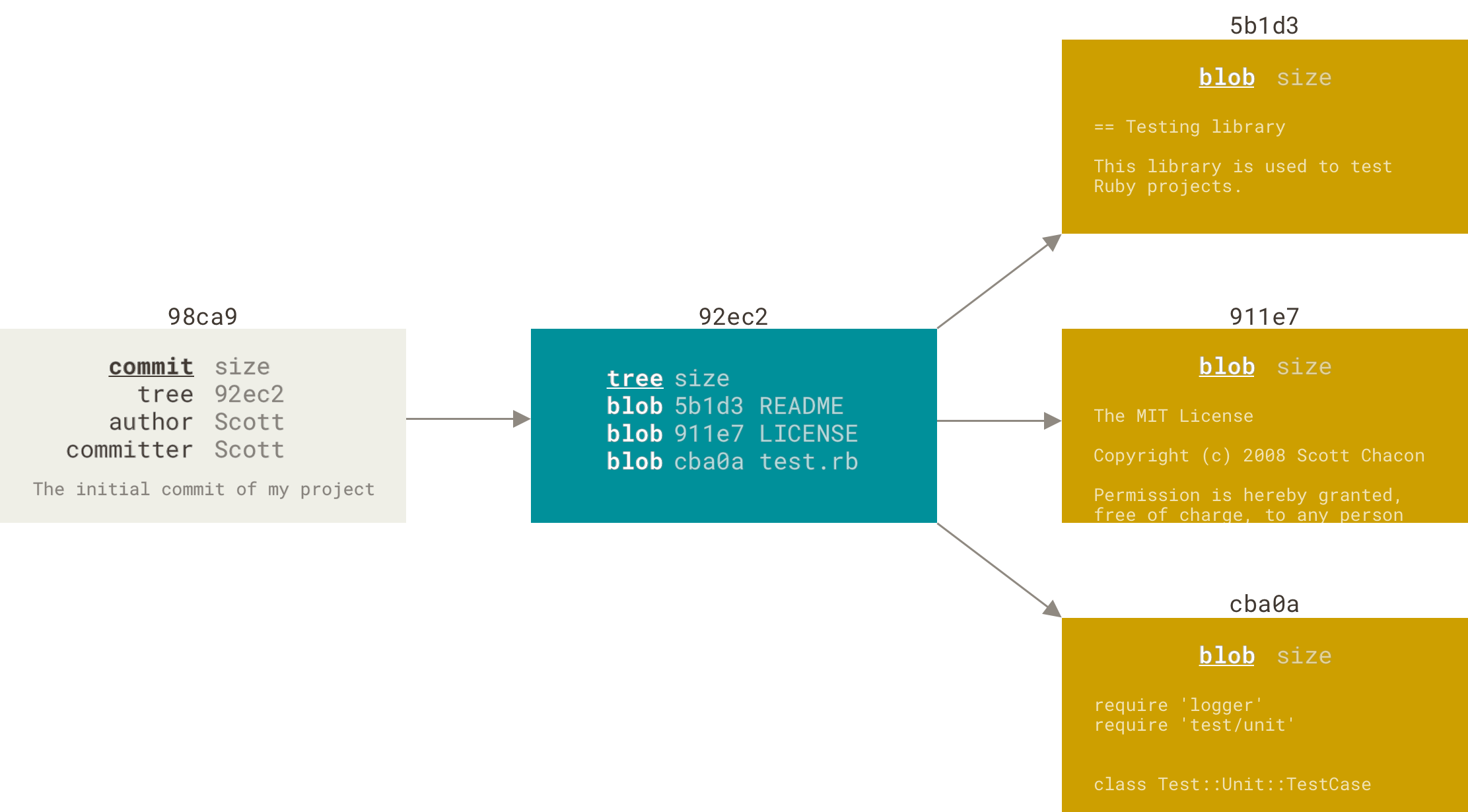
/Aside
Combining branches
When we are happy with the extra code we wrote on my_new_branch we want to merge it into master
$ git switch master # Switch to master
$ git merge my_new_branch # Merge my_new_branch into master
Updating c26f717..1359962
Fast-forward
example.txt | 2 ++
example2.txt | 1 +
2 files changed, 3 insertions(+)
create mode 100644 example2.txt
$ ls
example2.txt example.txt
Note that my_new_branch is untouched by the merge
Delete the branch
Now that we are done with the branch, we can delete it
$ git branch -d my_new_branch
Deleted branch my_new_branch (was 1359962)
This only deletes the reference - the file found in .git
$ ls .git/refs/heads
master
The database of files is still intact (our .git/objects directory)
Version Controlling
The whole point of a VCS is to be able to navigate between versions and we have a few ways to do that in git
Examine the history
$ git log
commit 1359962e527f4ab2c15c7703b233fb4e8a0afb83 (HEAD -> master)
Author: Anders Bogsnes <andersbogsnes@gmail.com>
Date: Mon Aug 10 15:03:13 2020 +0200
Committing to my branch
commit c26f7174f47f0781a8c4f83229d0c50b79a204c0
Author: Anders Bogsnes <andersbogsnes@gmail.com>
Date: Mon Aug 10 14:46:27 2020 +0200
My third commit
commit 90b8e5126da798b6e217f8dbdb3ec4354f534955
Author: Anders Bogsnes <andersbogsnes@gmail.com>
Date: Mon Aug 10 14:32:05 2020 +0200
Second commit
commit 722b3172cabe09b98d54ad91d9ceddd4c31e86aa
Author: Anders Bogsnes <andersbogsnes@gmail.com>
Date: Mon Aug 10 14:19:00 2020 +0200
Initial commit
A shorter version
$ git log --oneline
1359962 (HEAD -> master) Committing to my branch
c26f717 My third commit
90b8e51 Second commit
722b317 Initial commit
The number on the side is called the
SHA- it’s theIDgit uses, that we saw beforeWe can refer to a commit by it’s
SHAand we only need a few digits, enough to be unique
Timetravel with git
$ cat example.txt # Look at my file
My test file
Now has a more descriptive body
And some more texto
Fourth line of text
$ git switch -d 722 # Go back in time to SHA 722
$ ls
example.txt # No example2.txt!
$ cat example.txt # Look at the file again
My new text file # What I wrote in my file when I created it
$ git switch - # Go back to newest version of master
Restore a file
We can change a file to the way it looked before
$ git restore example.txt -s 722 # Restore the file from revision with SHA 722
$ ls
example2.txt example.txt
$ cat example.txt
My new text file
$ git status
On branch master
Changes not staged for commit:
(use "git add <file>..." to update what will be committed)
(use "git restore <file>..." to discard changes in working directory)
modified: example.txt
no changes added to commit (use "git add" and/or "git commit -a")
>>> git restore example.txt # Return the file to newest version of master
Undoing a commit
We often want to undo everything from one commit at a time
For example, we want to rollback a new feature which is bugged
We can do that in two ways:
- git reset
- git revert
Git revert
Create a new commit that does the opposite of the specified commit
$ git log --oneline
* 1359962 (HEAD -> master) Committing to my branch
* c26f717 My third commit
* 90b8e51 Second commit
* 722b317 Initial commit
$ git revert 135
Removing example2.txt
[master 0f7f27d] Revert "Committing to my branch"
2 files changed, 3 deletions(-)
delete mode 100644 example2.txt
$ ls
example.txt
Revert is most often used when we have published our changes and don’t want to change the history
We will talk more about publishing later
Git reset
Chop out all commits after the specified one. Resets the history as if that revision is the newest
$ git log
0f7f27d (HEAD -> master) Revert "Committing to my branch"
1359962 Committing to my branch
c26f717 My third commit
90b8e51 Second commit
722b317 Initial commit
$ git reset 1359
Unstaged changes after reset:
M example.txt
D example2.txt
$ git log
1359962 (HEAD -> master) Committing to my branch
c26f717 My third commit
90b8e51 Second commit
722b317 Initial commit
This is a bit harder to undo as our label is now pointing to a different commit - the other commits are orphaned
If you are unsure you’re doing it right - write down the SHA of the commit you’re currently on - that way you can always get back
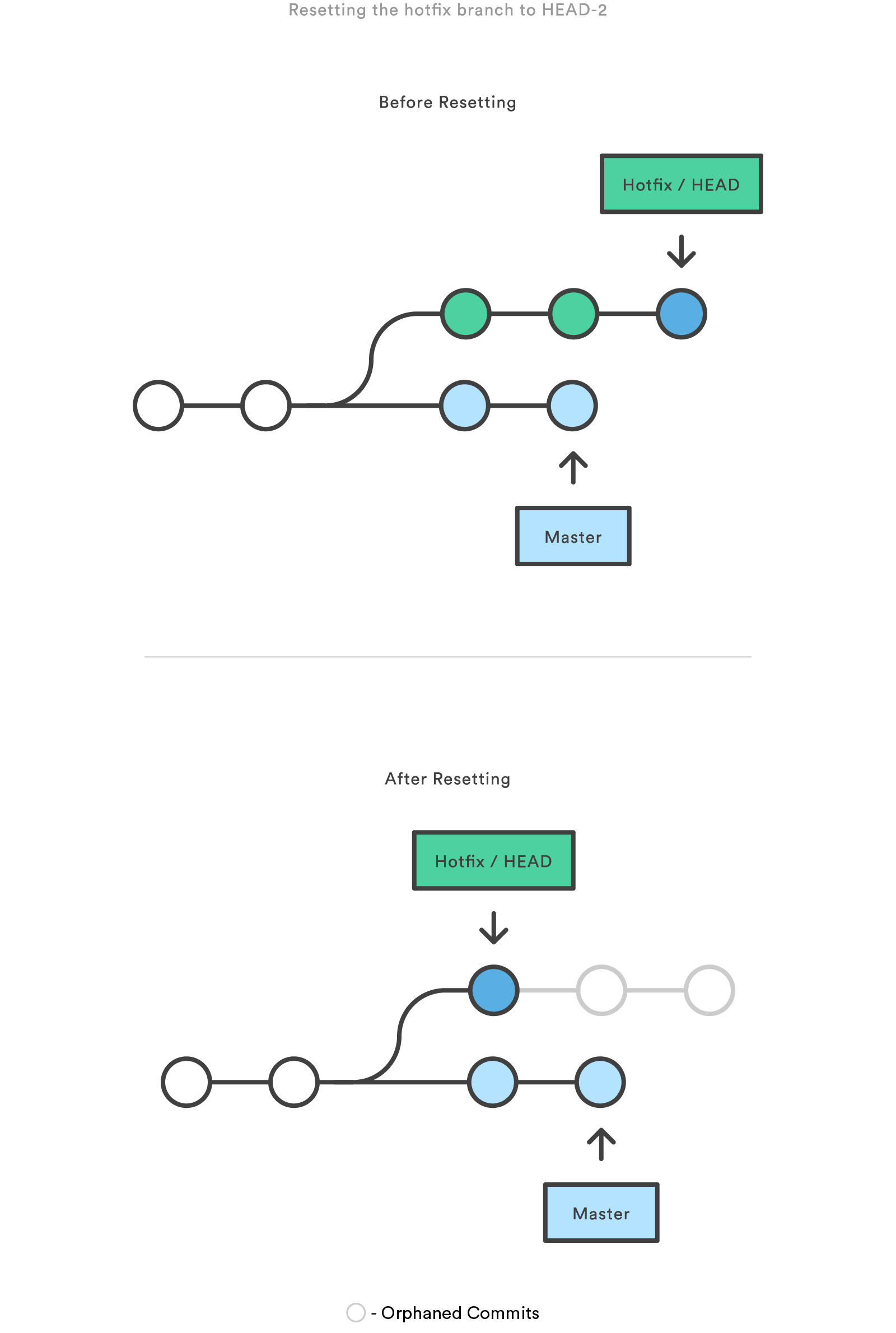
Reflog
We can also see a history of when we changed HEAD (our current location) by using git reflog
$ git reflog
1359962 (HEAD -> master) HEAD@{0}: checkout: moving from 1359962e527f4ab2c15c7703b233fb4e8a0afb83 to master
1359962 (HEAD -> master) HEAD@{1}: checkout: moving from master to 1359962
1359962 (HEAD -> master) HEAD@{2}: reset: moving to 1359962
0f7f27d HEAD@{3}: revert: Revert "Committing to my branch"
1359962 (HEAD -> master) HEAD@{4}: reset: moving to HEAD@{3}
1359962 (HEAD -> master) HEAD@{5}: reset: moving to HEAD@{2}
90b8e51 HEAD@{6}: checkout: moving from master to master
90b8e51 HEAD@{7}: reset: moving to 90b8e51
1359962 (HEAD -> master) HEAD@{8}: checkout: moving from 722b3172cabe09b98d54ad91d9ceddd4c31e86aa to master
722b317 HEAD@{9}: checkout: moving from master to 722b317
1359962 (HEAD -> master) HEAD@{10}: checkout: moving from 722b3172cabe09b98d54ad91d9ceddd4c31e86aa to master
722b317 HEAD@{11}: checkout: moving from master to 722b317
1359962 (HEAD -> master) HEAD@{12}: checkout: moving from 722b3172cabe09b98d54ad91d9ceddd4c31e86aa to master
Then we can do git switch as normal
Fixing detached state
When we switch to a given commit, git warns us
You are in 'detached HEAD' state. You can look around, make experimental
changes and commit them, and you can discard any commits you make in this
state without impacting any branches by switching back to a branch.
If you want to create a new branch to retain commits you create, you may
do so (now or later) by using -c with the switch command. Example:
git switch -c <new-branch-name>
Or undo this operation with:
git switch -
Git is lettting us know that we are no longer on a branch, so any changes we make won’t have a label (unless you write down the SHA)
If we want to put a label on the commit, we can use switch -c to create a new branch or we can get back to labelled territory with
git switch - to take you back to the last branch you were on
Exercise
- Switch to an earlier commit
- Create a new branch from that commit
- Make a change to a file
- Add and commit that change
- Go back to master
- Run
git log --graph --all --oneline
Where is your new branch coming from?
Git Flow
Git is a flexible tool, and many different workflows have built up around how to use git when working in teams
Git flow is one such workflow which has become very popular.
The branches
Git flow has five main types of branches
- master
- develop
- feature
- release
- hotfix
Master
- Always contains the code that is in production
- This is the branch we deploy to production
Develop
- Where the newest features are included, but is not yet released
- Should generally be ready to release
- The branch we merge into when our features are done
- Where features branch from
Feature
- Represents a new unit of work we want to do
- Should be short-lived and contain only the code necessary to implement the new feature
- One issue/feature per feature branch
- Merged into develop
Release
- Created to release a new version
- Represents a release
- Generally only bump version number
- Merge into master and develop
Hotfix
- Only for critical bugs that can’t wait for a new release
- Based off of
masterand notdevelop - Is merged into
masteranddevelop

Vincent Driessen@nvie.com
Benefits
- Feature workflow makes it easy to do code reviews
- Having a dedicated production branch makes it easy to see what was in production when
- Easy to collaborate on new features
Negatives
- Lots of branching
- Only enforced by convention
Additional resources
The Central repository
When working with others, we want a central repository that we synchronize our local repository with
That way, we can share our changes easily!
The main players
The main companies offering these services are
- Github (bought by Microsoft)
- Gitlab (independent)
- Bitbucket (Atlassian)
- Azure Devops? (old Team Foundation Server)
For this workshop, we will use Gitlab
Setup gitlab.com
Everyone will need a gitlab.com account
- Setup an account at gitlab.com
- Setup ssh keys (under Settings/SSH Keys - follow the instructions to generate new ones)
Pair up two and two (or three). Do the rest of the exercise on one machine
Exercise
- Create a new directory on your machine called
calculator - In that directory, create a new file called
calculator.py - Define a function
add(a, b)that returns the sum of a + b - Run git init, add and commit
- Create a new project in Gitlab called calculator - set it to public and don’t click “Initialize repository with a README”
Linking local repo to Gitlab
We need to tell git about our remote repository
$ git remote add origin git@gitlab.com:andersbogsnes/calculator.git
Creates a label origin 👉 my_long_url_i_cant_remember
Push - Update remote from local
$ git push -u origin master
I want to push my changes from my local branch to the branch named master at the url specified in origin and I want to link these two branches (-u)
Set up a develop branch
- We want to practice git flow, so we need a develop branch
# Create a new branch called develop and switch to it
$ git switch -c develop
# Push local branch develop to origin's develop branch
$ git push -u origin develop
- Go to gitlab and set development as your default branch (Settings/Repository)
Exercise
Add your partner to your repo
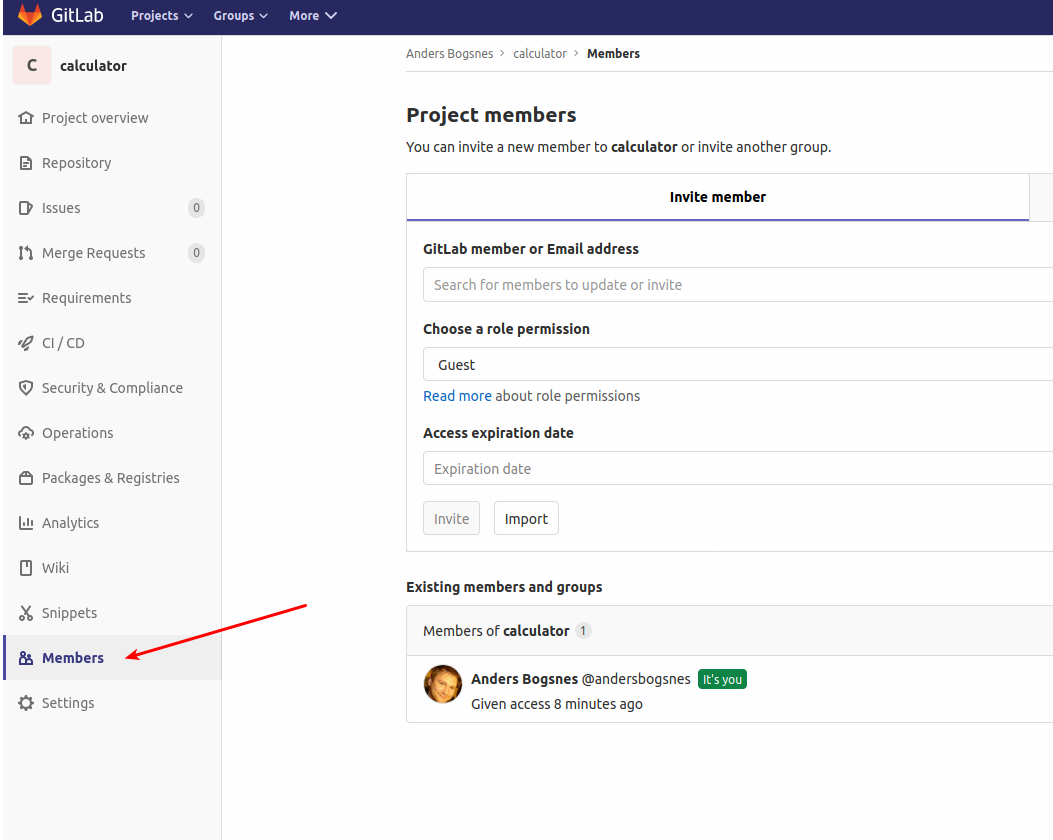
Clone the repo
Your partner should now clone the repo

$ git clone git@gitlab.com:andersbogsnes/calculator.git
clonecreates a full copy of a repository to have locally- We are only copying files back and forth - there is no other link!
Exercise
One person
- Create a new feature branch
- add a new function
subtract(a, b)which subtracts two numbers - push the new branch to gitlab
- create a merge request
Merge requests
Github calls it a merge request, everyone else calls it a pull request
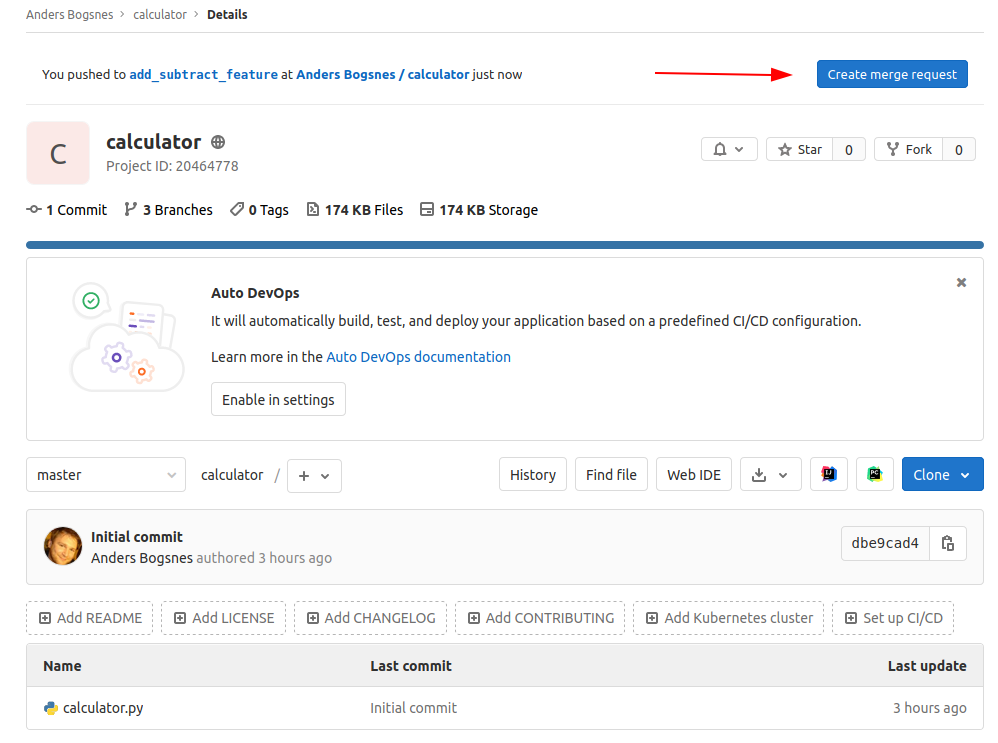
Creating a merge request

Ready for review
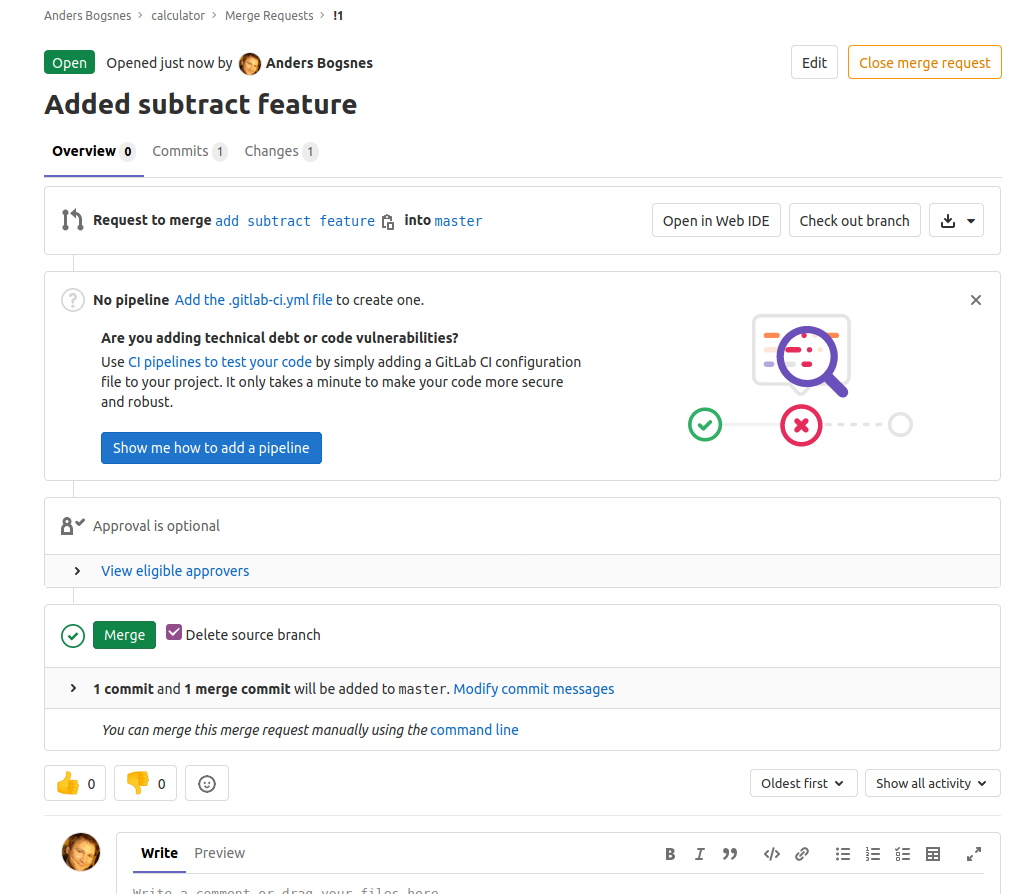
Exercise - 1 min
One person
- Click on changes
- Make a comment on the code
- Resolve the conversation
- Make another comment on the code
- Resolve the comment in a new issue
- Merge the request
Git pull
There are new changes in the central repository so we need to update our local repository to get the changes
Central vs local repository
- You have two separate copies of the repository, one local and one in the central repository
git pullwill asks the central repo if it has any commits that are not present locally- If it does, git will do a
merge, merging the new commits into your local commits
CI/CD
Integration and Deployment
- Integration means adding new code to our codebase
- Deployment means deploying new code to production
CI/CD providers
Many providers in the market
- Travis
- CircleCI
- Jenkins
- Github Actions
- Azure Pipelines
- Gitlab CI/CD
- Argos
Integration
Gitlab has CI/CD built-in and we are going to add some integration steps
When new code is pushed to gitlab, we want to
- Lint the code
- Run unit tests
The config file
Gitlab looks for a file named .gitlab-ci.yml which describes what jobs to run
image: python:3.8.5-slim # What docker image to use
lint: # a job name - can be anything
script: # A list of commands to run
- pip install flake8
- flake8
test:
script:
- pip install pytest
- pytest
Exercise
- Add the .gitlab-ci.yml to a new branch
- Push the new branch
- What happens?
A failing pipeline
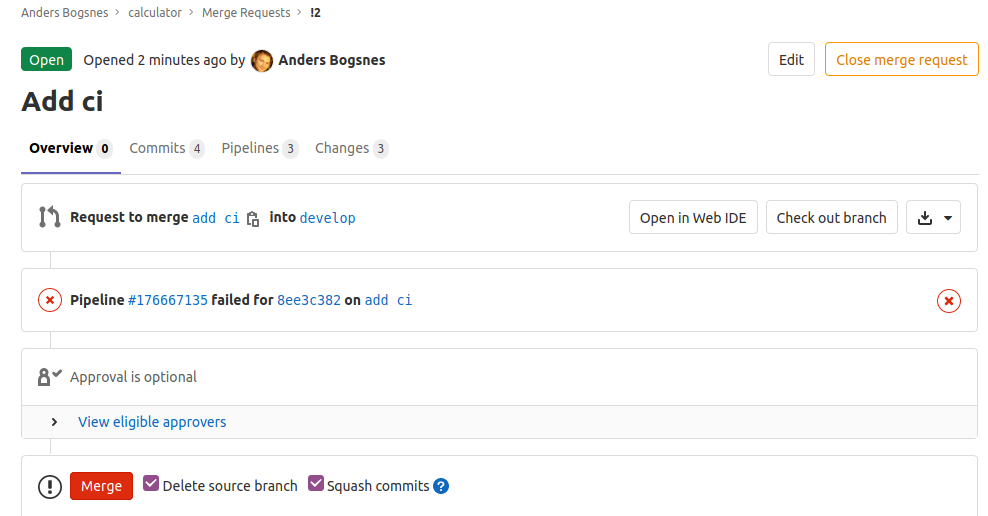
Pipeline overview

Pipeline logs
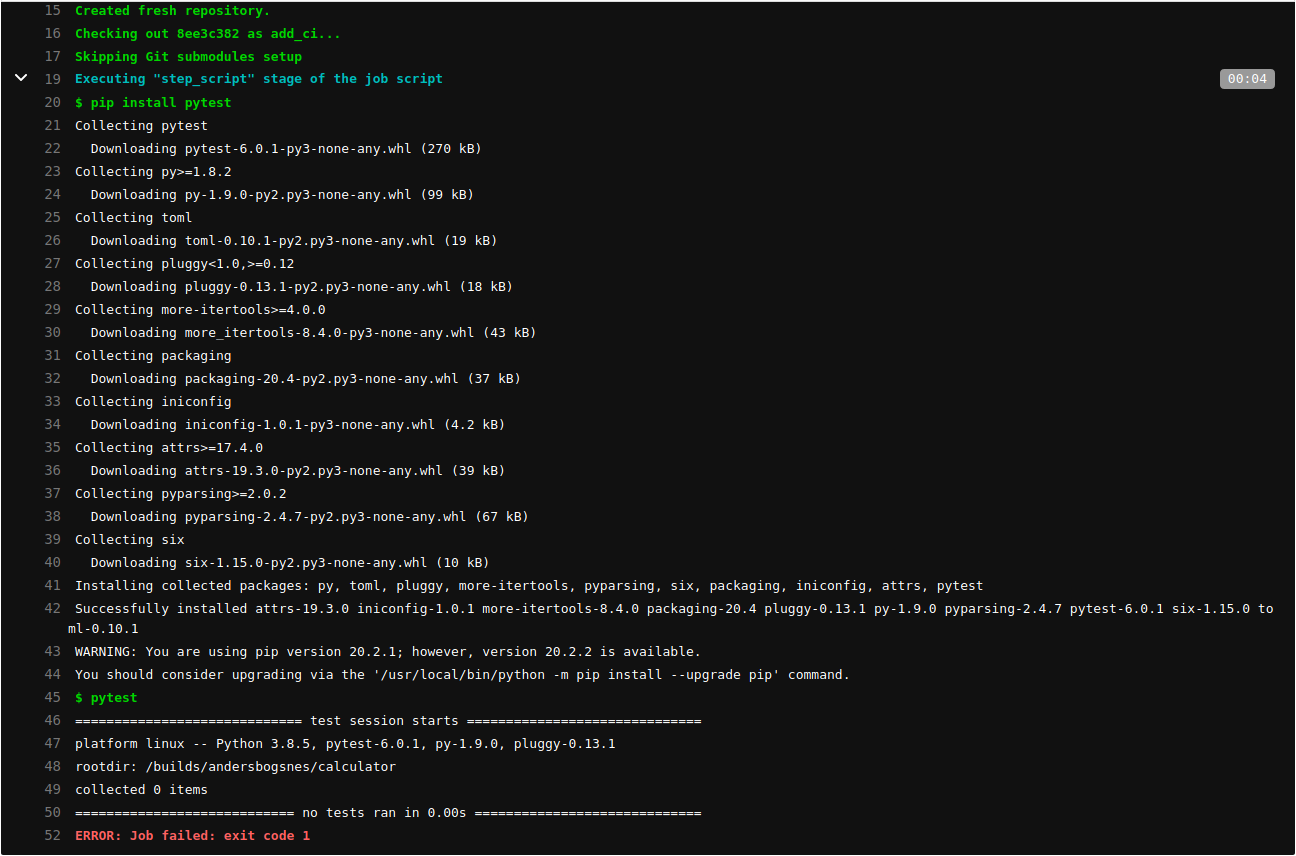
Aside - exit codes
Exit codes is a number returned by a command-line program
- 0 is good
- Not 0 is bad
Fix failing CI
We need to write some tests!
Exercise
- Create a
test_calculator.py - Write some tests for the add function
- Write some tests for the subtract function
- Git add, commit, push
- Get to a passing pipeline!
Happy pipeline

Happy team
With CI turned on, your teammates can be confident that the code in develop and master is tested and linted
- Reduces errors
- Reduces codereview (we don’t codereview failing code!)
- We know that when we deploy, our code is passing all tests
Exercise
- Add pytest-cov coverage to CI
- Add black formatting
- Add mypy (and type hints)

